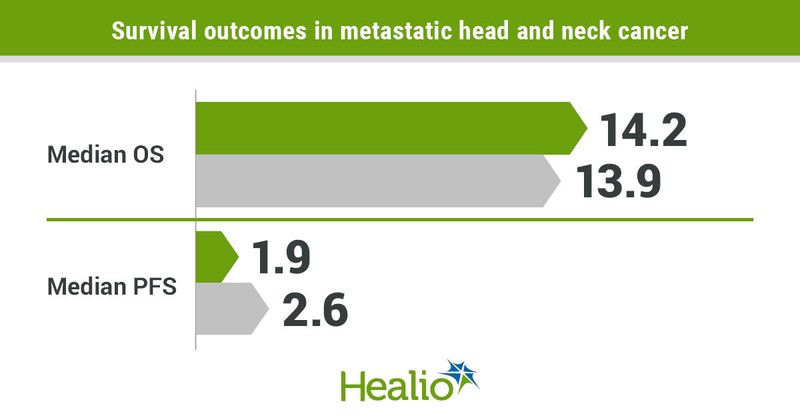Addition of SBRT to nivolumab fails to improve outcomes in metastatic head and neck cancer
The addition of stereotactic body radiation therapy to nivolumab did not improve outcomes among a cohort of patients with metastatic head and neck squamous cell carcinoma, according to a study published in Journal of Clinical Oncology.
“During a time with reports of abscopal effects — preclinical and case reports — we felt that only a randomized trial can definitively answer the question of whether abscopal effects truly exist in patients with metastatic head and neck squamous cell carcinoma,” Nancy Y. Lee, MD, FASTRO, vice chairman and radiation oncologist in the department of radiation oncology at Memorial Sloan Kettering Cancer Center, told Healio. “In this uniform cohort of patients, we did not observe any abscopal effects.”

Previous research has shown a modest objective response rate with anti-PD-1 therapy among patients with metastatic or recurrent HNSCC. Lee and colleagues sought to determine whether anti-PD-1 therapy could act synergistically with radiotherapy to improve immune responses.

The single-center, randomized, phase 2 trial included 62 patients (median age, 63 years; range, 29-83) with metastatic HNSCC who had at least two metastatic lesions — one that could be safely irradiated and one measurable by RECIST version 1.1. Researchers stratified patients by HPV status and randomly assigned them 1:1 to the anti-PD-1 antibody nivolumab (Opdivo, Bristol Myers Squibb), dosed at 3 mg/kg IV every 2 weeks, either alone (n = 30) or with SBRT, dosed at 9 Gy in three fractions to one lesion (n = 32).
The ORR analysis included 29 patients in the nivolumab monotherapy group and 31 in the SBRT combination group who received treatment and had at least one set of on-treatment images.
ORR in nonirradiated lesions served as the primary endpoint. OS, time from random assignment to death or last follow-up for censored patients, PFS and time from random assignment to RECIST-defined progressive disease, death due to any cause, or last follow-up for censored patients served as secondary endpoints.
Among the 31 patients in the SBRT group, the targets eligible for primary outcome analysis included lung parenchyma (58.1%), lymph node (16.1%), bone (12.9%), liver (9.7%) and soft tissue (3.2%).
Researchers observed no significant difference in ORR between patients assigned nivolumab alone (34.5%; 95% CI, 19.9-52.7) and those assigned SBRT plus nivolumab (29%; 95% CI, 16.1-46.6). In addition, they found no significant differences between the nivolumab monotherapy and SBRT combination groups in OS (median, 14.2 months vs. 13.9 months), PFS (median, 1.9 months vs. 2.6 months) or response duration (median, not reached vs. 9.4 months). Rates of grade 3 to grade 5 adverse events appeared comparable between the groups (13.3% vs. 9.7%).
Results of a preplanned subgroup analysis of patients in the SBRT combination group showed patients with HPV-negative disease achieved a numerically superior response to treatment than those with HPV-positive disease (26.7% vs. 14.2%).
“We only radiated one lesion in this study, so perhaps radiating more than one lesion and also using functional imaging to determine which lesion should be radiated could be assessed in future research,” Lee said.
The study by McBride and colleagues provides the clearest evidence yet that the abscopal effect, contrary to the widely held perception in the field, remains exceedingly rare and is not clinically relevant when using anti-PD-1/PD-L1 therapies and SBRT for head and neck cancer, Johns Hopkins University researchers Tanguy Y. Seiwert, MD, of department of medical oncology, and Ana P. Kiess, MD, PhD, of the department of radiation oncology, wrote in an editorial accompanying the study.
“In combination with other recent data of standard fractionated radiation with anti-PD-1/PD-L1, we should take this study to guide us to explore promising approaches in rigorous clinical trials, with a focus on sequential approaches such as definitive radiotherapy followed by immunotherapy, consolidative SBRT of all tumor sites in combination with immunotherapy, and trials that incorporate surrogate immunotherapy-relevant biomarkers to assess earlier and more efficiently the impact of an intervention,” they wrote.
References:
McBride S, et al. J Clin Oncol. 2020;doi:10.1200/JCO.20.00290.
Seiwert TY and Kiess AP. J Clin Oncol. 2020;doi:10.1200/JCO.20.02046.
For more information:
Nancy Y. Lee, MD, FASTRO, can be reached at Memorial Sloan Kettering Cancer Center, 633 Third Ave., 2nd Floor, New York, NY 10017; email: leen2@mskcc.org.

